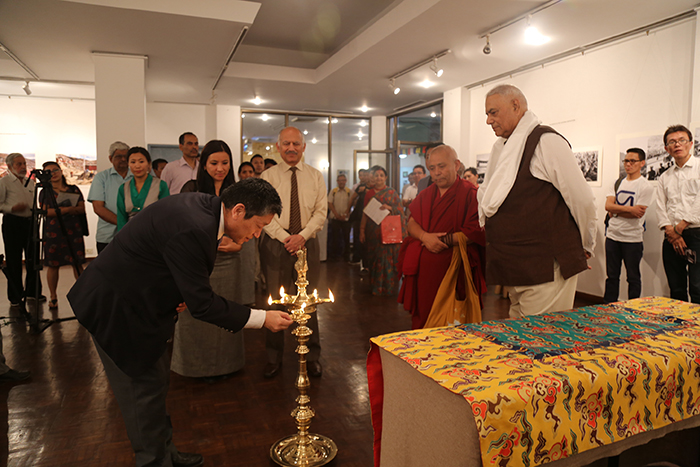Cultural Revolution In Tibet Most Anti-Cultural In Human History: Former Indian Foreign Minister
[Source: tibet.net]

Former Indian Foreign and Finance Minister Shri Yashwant Sinha Inaugurates the Photo Exhibition on ‘Revisiting Cultural Revolution in Tibet.’ Photo @ Namgyal Tsewang, DIIR
New Delhi: The Tibet Museum of Department of Information and International Relations (DIIR), Central Tibetan Administration (CTA) in collaboration with India International Centre (IIC) and Bureau of His Holiness the Dalai Lama, Delhi launched a week-long photo exhibition titled ‘Revisiting the Cultural Revolution in Tibet: A Photo exhibition’ showcasing the Cultural Revolution in Tibet, its ramifications on Tibetan culture and religion and how it is reviving in Tibet today.
Former Indian Foreign and Finance Minister Shri. Yashwant Sinha graced the inauguration of photo exhibition this evening as the chief guest. Other dignitaries include Archarya Yeshi Phuntosk, Deputy Speaker, Tibetan Parliament in Exile, Dongchung Ngodup Dorjee, Representative of His Holiness the Dalia Lama in Delhi, and Former Minister of CTA, Dhardon Sharling, Secretary, DIIR, Shri Air Marshal Naresh Verma, Director of IIC and Tsewang Gyalpo Arya, Secretary of Bureau of His Holiness the Dalai Lama. A select audience of over seventy and members of media attend the event.
The event was moderated by Kalden Tsomo, head of UN and Human Rights Desk, DIIR.

Representative of His Holiness the Dalai Lama in New Delhi, Dhongchung Ngodup Dorjee lights the lamp at the inauguration of the Photo Exhibition on ‘Revisiting Cultural Revolution in Tibet.’ Photo @ Namgyal Tsewang, DIIR
Shri Yashwant Sinha said “in the history of humanity, never has been anything more anti-cultural than the so called cultural revolution.”
“The Tibetan struggle shows how indomitable the human spirit is and resonates with a quote of Mahatma Gandhi Ji: they can break our limps but not our spirit,” said India’s former Foreign Minister.
He also expressed confidence that people of Tibet will see a new dawn and assured the steadfast support of Indian government and people to ensure that the Tibetan struggle will persist and the sacrifices of Tibetan people will not go in vain.
Admonishing China’s objection to His Holiness the Dalai Lama’s April 4 visit to the India state of Arunachal Pradesh, Shri Yashwant Sinha said “China has no business to tell us where His Holiness can go.’
Tashi Phuntsok, Director of Tibet Museum in his introductory remarks said “although the Cultural Revolution is said to have ended forty years ago, China’s continuing hardline policies in Tibet serve as an evidence of its attempt to erase Tibet’s past, present and future.”
Dhardon Sharling, Secretary of DIIR while delivering her address and said the Cultural Revolution is a big blot in China’s history, which cannot be erased and claimed that the cultural revolution continues to this day as evidenced in the case of Larung Gar.
“Today’s China, while desperately trying to break away from the image of a totalitarian system, driven by a failing ideology, still sees personal choice and religious belief a threat to its own survival. This fear of people of faith follows a disturbing trend from the pervasive state control over its Muslim population during the Ramadan month, to the bulldozing of Christian churches and now to the ongoing destruction at Larung Gar Buddhist academy at Serthar in Tibet,” said Dhardon.
She further said “though the cultural revolution will bring back bitter memories of an atrocious past but on the brighter side the cultural resilience of Tibetans inside Tibet have kept alive the hope for a peaceful resolution to the Tibet issue.”
The photo exhibition showcases 54 photographs categorised in seven parts: Beginning of the Cultural Revolution, Destruction of Joking Temple, Struggle Session (Thamzing), Creation of new God, Name Change, Destructions of Monasteries and Revival of Cultural Revolution in Tibet.
The pictures depict some of the horrifying episodes that happened during the ten-year long (1966-76) assault on Tibetan culture and religion under the name of Cultural Revolution.
The exhibition will be open to public from 11 am – 7 pm, April 2-8, 2017 at the Annex building, IIC.

The Tibet Museum Director Tashi Phuntsok guides Shri Yashwant Sinha at the inauguration of Photo Exhibition on ‘Revisiting Cultural Revolution in Tibet.’ Photo @ Namgyal Tsewang, DIIR
